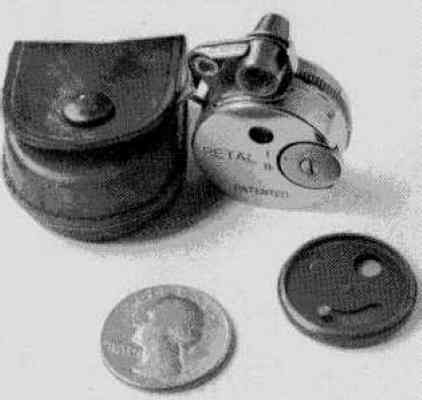
WHAT IS SUBMINIATURE PHOTOGRAPHY?


Why would someone want a camera this small? Some people want small cameras so that they can always have a camera with them. Others want small cameras so that they can take pictures without anyone knowing that a picture is being taken.
But making cameras smaller has its price. Something has to "give". Usually, smaller cameras have fewer features, such as no automatic focusing, no automatic exposure and no built-in flash. In addition, smaller cameras usually mean smaller negatives and more grain in the resulting prints. Last, but not least, smaller cameras often mean higher production costs, due to the miniaturization of the parts. But for submini enthusiasts it's all worth it!
There are many definitions of the term "subminiature". The traditional definition is "any format smaller than the standard miniature format" -- hence the name "sub-miniature" or submini. The "miniature" format is actually the standard 35mm format -- 24mm x 36mm -- so the most liberal definition of "subminiature" is any camera that produces a format small than this. But this includes some pretty large cameras. Many authors have defined the term more conservatively. In their mind, the term "subminiature" should only be applied to cameras, rather than formats. Any camera that attempts to be smaller than a "standard" 35mm camera would qualify. But trying to define what a "standard" 35mm camera-size is can be very difficult.
In other words, you can define "submini" any way you want -- but be prepared to defend your position! For the purposes of this web site, a subminiature camera is arbitrarily defined as any still camera that exclusively uses a single film format smaller than 16.7mm x 30.2mm -- the size of the APS format. This definition excludes stereo cameras (even if the film format is smaller that APS), cameras with multiple formats (such as the Konica Autoreflex which shoots full-frame and half-frame images), small full-frame 35mm cameras (such as the Olympus XA and Rollei 35 series), cameras that can take still and moving pictures (even though they use 16mm or 8mm film), all of the APS format cameras, and other hybrids.
Lastly, keep in mind that there is no perfect submini camera or submini format. Different photographers choose different formats and camera styles -- for different reasons. Some opt for the smallest cameras, while other prefer those with larger formats or more features. Others just can't make up their minds and get a variety of submini cameras -- and there are THOUSANDS to choose from! Just like in all the other areas of photography, there are excellent quality submini cameras that will produce excellent results, and there are poorly designed or cheaply made cameras that will give less-than-stellar results. But much depends on the photographer who is using the camera. Many submini enthusiasts are collectors, as opposed to users, and are less concerned with picture quailty and more concerned with camera uniqueness.
We hope you enjoy your exploration of the subminiature photographic world. At this web site you will find everything you need to understand, select, find, use, repair, display AND ENJOY(!) your submini camera and results. Happy Shooting.
To return to the main index for the Sub Club click here.
COPYRIGHT @ 1995, 1996, 1997, 1998, 1999, 2000, 2001, 2002, 2003, 2004, 2005 by Joe McGloin. All Rights Reserved.